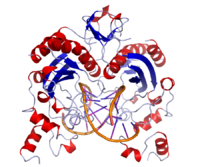
EcoRV
Encyclopedia



Endonuclease
Endonucleases are enzymes that cleave the phosphodiester bond within a polynucleotide chain, in contrast to exonucleases, which cleave phosphodiester bonds at the end of a polynucleotide chain. Typically, a restriction site will be a palindromic sequence four to six nucleotides long. Most...
isolated from certain strains of Escherichia coli
Escherichia coli
Escherichia coli is a Gram-negative, rod-shaped bacterium that is commonly found in the lower intestine of warm-blooded organisms . Most E. coli strains are harmless, but some serotypes can cause serious food poisoning in humans, and are occasionally responsible for product recalls...
. It has the alternative name Eco32I.
In molecular biology
Molecular biology
Molecular biology is the branch of biology that deals with the molecular basis of biological activity. This field overlaps with other areas of biology and chemistry, particularly genetics and biochemistry...
, it is a commonly used restriction enzyme
Restriction enzyme
A Restriction Enzyme is an enzyme that cuts double-stranded DNA at specific recognition nucleotide sequences known as restriction sites. Such enzymes, found in bacteria and archaea, are thought to have evolved to provide a defense mechanism against invading viruses...
. It creates blunt ends. The enzyme recognizes the palindromic 6-base DNA sequence 5'-GAT|ATC-3' and makes a cut at the vertical line. The complementary sequence is then 3'-CTA|TAG-5'. The ends are blunt and can be ligated into a blunt cloning site easily but with lower efficiency than sticky ends.
Structure
EcoRV has been cocrystallized with the sequence it normally cuts. This crystal was used to solve the structure http://www.pdb.org/pdb/explore.do?structureId=1AZ0 of the complex.The core of the enzyme consists of a five-stranded mixed β-sheet flanked by α-helices. The core is conserved in all other type II restriction endonucleases. It also has an N-terminal dimerization subdomain formed by a short α-helix, a two-stranded antiparallel -sheet, and a long α-helix. This subdomain is found only in EcoRV and PvuII.
Mode of action
Like EcoRIEcoRI
EcoRI is an endonuclease enzyme isolated from strains of E. coli, and is part of the restriction modification system.In molecular biology it is used as a restriction enzyme. It creates sticky ends with 5' end overhangs...
, EcoRV forms a homodimer in solution before binding and acting on its recognition sequence
Recognition sequence
The recognition sequence, sometimes also referred to as recognition site, of any DNA-binding protein motif that exhibits binding specificity, refers to the DNA sequence , to which the domain is specific...
. Initially the enzyme binds weakly to a non-specific site on the DNA. It randomly walks along the molecule until the specific recognition site is found. EcoRV has a high specificity for its target DNA sequence.
Binding of the enzyme induces a conformational change in the DNA, bending it by about 50°. DNA bending results in the unstacking of the bases, widening of the minor groove, and compression of the major groove. This brings the phosphodiester linkage to be broken closer to the active site of the enzyme, where it can be cleaved. Cleavage occurs within the recognition sequence, and does not require ATP hydrolysis.
EcoRV is the only type II restriction endonuclease
Endonuclease
Endonucleases are enzymes that cleave the phosphodiester bond within a polynucleotide chain, in contrast to exonucleases, which cleave phosphodiester bonds at the end of a polynucleotide chain. Typically, a restriction site will be a palindromic sequence four to six nucleotides long. Most...
known to cause a major protein-induced conformational change in the DNA.
Uses
EcoRV is often used to cut open a plasmidPlasmid
In microbiology and genetics, a plasmid is a DNA molecule that is separate from, and can replicate independently of, the chromosomal DNA. They are double-stranded and, in many cases, circular...
vector to insert a gene
Gene
A gene is a molecular unit of heredity of a living organism. It is a name given to some stretches of DNA and RNA that code for a type of protein or for an RNA chain that has a function in the organism. Living beings depend on genes, as they specify all proteins and functional RNA chains...
-of-interest during gene cloning. The enzyme is supplied by many manufacturers and requires bovine serum albumin
Bovine serum albumin
Bovine serum albumin is a serum albumin protein derived from cows. It is often used as a protein concentration standard....
to work properly.
See also
- EcoRIEcoRIEcoRI is an endonuclease enzyme isolated from strains of E. coli, and is part of the restriction modification system.In molecular biology it is used as a restriction enzyme. It creates sticky ends with 5' end overhangs...
, another nuclease enzyme from E. coli. - EcoRII, another nuclease enzyme from E. coli.
- FokIFokIThe enzyme FokI, naturally found in Flavobacterium okeanokoites, is a bacterial type IIS restriction endonuclease consisting of an N-terminal DNA-binding domain and a non-specific DNA cleavage domain at the C-terminal...
, a nuclease enzyme from Flavobacterium okeanokoites

